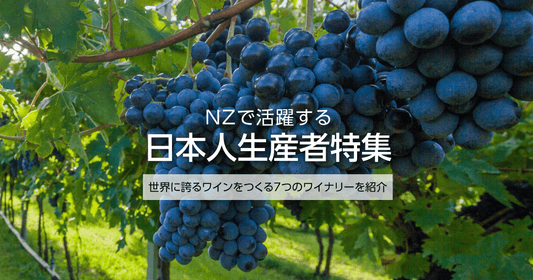New Zealand Winegrowers has released the 2023 edition of its Vintage Indicator .
▶ New Zealand Winegrowers official website
This time, based on that data, we will be providing you with information on New Zealand wine vintages.
What is a "vintage indicator"?
It is an index that summarizes the harvest volume of wine grapes for that year. Since NZ is in the southern hemisphere, the grape harvest ends in February to April, and the "Annual Grape Harvest Ranking" is announced around June to July.
Last year's article is here.
Now, let me briefly explain New Zealand's wine grape harvest in 2023 and related trends.
2023 grape harvest and recent production trends
| Vintage year | Overall yield |
|---|---|
| 2022 | 532,000t |
| 2023 | 501,000t (-6%) |
Reference data: NZ Wine Vintage Indicators
The harvest was slightly less than last year. What could be the reason?
In fact, in January and February of 2023, just before the grape harvest season, New Zealand was hit by a severe natural disaster.
The heavy flooding in January and the cyclone in February caused a significant reduction in harvest yields in some areas, and the effects are thought to be felt throughout New Zealand.
Ranking of harvest yields by region
The yields by region are as follows:
| region | Harvest yield (percentage) | YoY comparison |
|---|---|---|
| Marlborough | 393,865t (81.3%) | -5% |
| Hawke's Bay | 38,409t (7.9%) | -4% |
| Central Otago | 11,955t (2.5%) | -5% |
| Nelson | 11,472t (2.4%) | +6% |
| Gisborne | 10,967t (2.3%) | -43% |
| North Canterbury | 11,090t (2.3%) | +13% |
| Wairarapa | 5,528t (1.0%) | +3% |
| Auckland | 709t (0.1%) | -47% |
Reference data: NZ Wine Vintage Indicators

Auckland and Gisborne experience significant declines in harvest yields
The grape harvest in Auckland and Gisborne was significantly reduced due to the severe flooding that occurred mainly in Auckland at the end of January and the powerful Cyclone Gabriel that struck the North Island in early February.
In Hawke's Bay, where figures show a mere 4% decrease, some wineries suffered devastating damage from Gabriel.
Ranking of harvest yields by grape variety
Next, let's look at the yields for each grape variety.
| variety | Harvest yield (percentage) | YoY comparison |
|---|---|---|
| Sauvignon Blanc | 378,330t (78.1%) | -4% |
| Pinot Noir | 30,532t (6.3%) | -12% |
| Pinot Gris | 26,097 (5.4%) | -14% |
| Chardonnay | 22,528t (4.6%) | -twenty four% |
| Merlot | 9,092t (1.9%) | +21% |
| Riesling | 6.001t (1.2%) | +19% |
Reference data: NZ Wine Vintage Indicators
Merlot and Riesling yields up, other varieties down
The varietal rankings were unchanged from last year, with a slight decline in Sauvignon Blanc and declines in Pinot Noir, Pinot Gris and Chardonnay, most likely linked to the floods and cyclones in the North Island.
On the other hand, although Merlot and Riesling did not have large initial yields, 2023 will be a bumper harvest, with yields about 20% higher than last year.
Good news for NZ wine
Many wineries suffered major damage due to natural disasters, making the 2023 vintage a difficult year. However, New Zealand wine is becoming more and more prominent in the world. Here are two pieces of good news about New Zealand wine recently.
Exports up 25% from last year, making NZ the world's sixth largest wine exporter
Total New Zealand wine exports for the year to May 2023 are expected to be worth $2.4 billion, up 25% from last year.
Although NZ accounts for only 1% of the world's wine production, it is now ranked 6th in the world in terms of export value. Demand for NZ wine, especially Sauvignon Blanc, is growing significantly, especially in the United States.
Philip Gregan, CEO of the New Zealand Wine Growers Association, said:
"Record high wine exports into the world's largest and most competitive market is a fantastic achievement for New Zealand wine exporters and testament to the ever-growing global demand for New Zealand wine.
He commented,
New Zealand exports most of the wine it produces.
Many wineries strive to create flavors that will appeal to overseas customers, and I believe that as a result of these efforts, Japan has become one of the world's leading wine exporters.
Hawke's Bay named 'Great Wine Capital'
Also, in May of this year, Hawke's Bay in the North Island was named the 12th Great Wine Capital of the World.
The Great Wine Capitals was founded in Bordeaux in 1999 as a network of cities linking together the wine industry and tourism.
The Great Wine Capitals of the World recognises not only the cities and regions themselves, but also the region's wine-growing industry, history, wine tourism, educational opportunities and business.
The other 11 Great Wine Capitals of the World are:
- Adelaide (South Australia)
- Bilbao (Spain)
- Bordeaux (France)
- Cape Town, South Africa
- Lausanne (Switzerland)
- Mainz (Germany)
- Mendoza (Argentina)
- Porto (Portugal)
- San Francisco (USA)
- Valparaiso (Chile)
- Verona, Italy
Nowadays, the importance of wine tourism, which combines wine and tourism, is being emphasized in all wine-producing regions.
Although the Great Wine Capitals are not yet well known within the wine industry, we hope that this initiative, which shares ways of promoting the appeal of wine between different cities, will bear great fruit in the future.
The addition of Hawke's Bay to the list is good news for New Zealand wine fans, and it's likely that wine tourism in Hawke's Bay will become even more sophisticated in the future.
summary
Winemaking is heavily influenced by the weather and environment of the region, and looking at the data for New Zealand for 2023 again reminds us of this.
In 2023, some areas of the North Island experienced major natural phenomena beyond human control, such as floods and cyclones, which significantly reduced grape harvests. We have also heard reports of devastating damage to vineyards. We hope that they will recover as soon as possible and that the day will come when they can once again deliver delicious wine to the world.
In contrast, the South Island has been able to secure a stable harvest, almost the same as in previous years. White wine from the 2023 harvest will be available in Japan from the summer of 2023 onwards. Most red wines will be available from 2024 onwards.
When drinking these wines, I hope to enjoy them while remembering that each and every one is not a wine that can be taken for granted.






